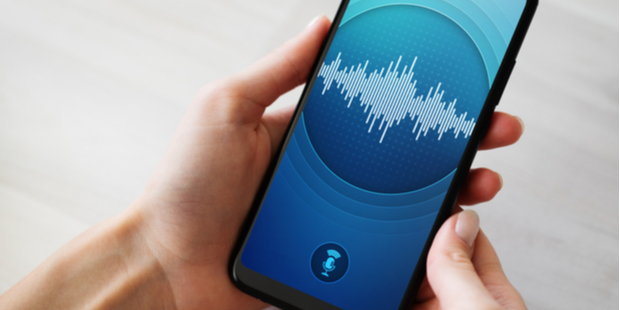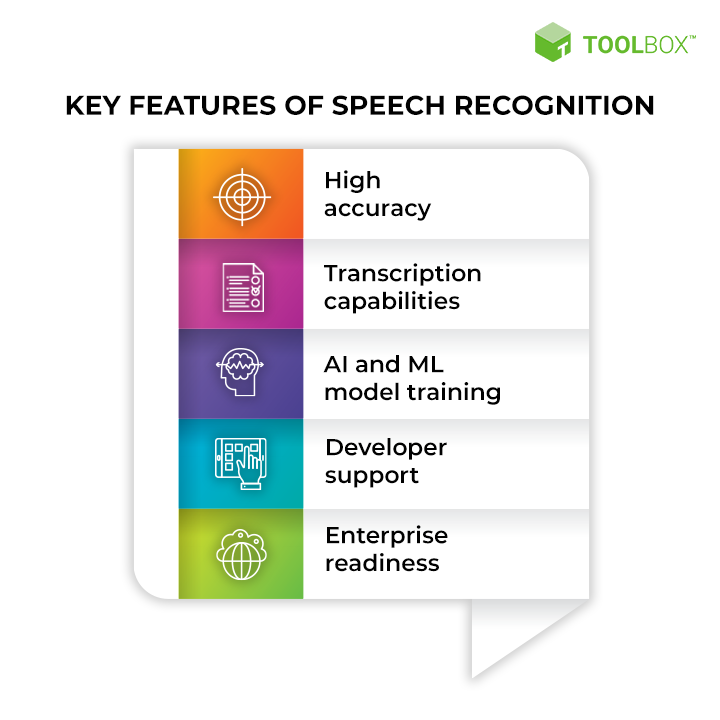Best Speech Recognition Software 2022

Speech recognition software processes speech uttered in a natural language and converts it into readable text with a high degree of accuracy, using artificial intelligence (AI), machine learning (ML), and natural language (NLP) techniques. This article discusses the key features of speech recognition software and the top 10 tools in this segment.
Understanding Speech Recognition Software and Its Key Features
Speech recognition software is defined as a technology that can process speech uttered in a natural language and convert it into readable text with a high degree of accuracy, using artificial intelligence (AI), machine learning (ML), and natural language (NLP) techniques.
Speech Recognition Process
While speech recognition software is primarily used for transcription, it can address a host of other use cases. For example, the software’s output can be used to run a voice-based search on voice-activated systems like virtual assistants and smart home appliances. The ability to recognize and convert speech also produces comprehensible data for analysis – for example, analyzing call records by integrating it with a cloud contact center.
Speech recognition software is a cognitive service that aims to replicate a human action. Just like human beings can recognize uttered speech, remember what is said, and respond appropriately, speech recognition technology endows machines with similar capabilities. In 2021, the global speech and voice recognition market was worth approximately $8.3 billion as per research by MarketsandMarkets (published in August 2021). This will reach $22 billion by 2026 due to major advancements in AI systems.
Enterprises can purchase speech recognition software to automate common tasks like document creation. Professionals can utilize these tools to boost their productivity by using their voice as a machine-readable input. When evaluating speech recognition software, one must consider the following key features:

Key Features of Speech Recognition
1. High accuracy
When a machine converts uttered speech into written text, it should be able to do so with moderate to high accuracy. Inaccurate recognition is of no use and is often counterintuitive to productivity, as the error correction process takes more time than manual transcription or typing. Typically, an accuracy level above 70% is considered “good,” meaning the software recognizes 70 words correctly out of every 100 words said.
2. Transcription capabilities
While the speech recognition engine can connect with an external transcription tool, it is helpful to have the two functions in one system. The software can understand and process voice inputs, generate a text transcription, and present it in a human-readable format – available for download as subtitled files or documents.
3. AI and ML model training
Speech recognition relies on sophisticated artificial intelligence (AI) that transforms voice inputs into large volumes of machine-readable information. One of the key benefits of AI is that it can become more accurate with every use session by learning from the exceptions and errors that arise. This occurs through machine learning, and one should be able to train the software AI and ML model to improve accuracy.
4. Developer support
While several speech recognition platforms are ready for use, one should also look for developer support. This means that application programming interfaces (APIs) should be available to embed the functionality in other applications. For example, a developer may leverage a speech recognition API to build their industry-specific voice assistant to search through complex knowledge repositories.
5. Enterprise readiness
In addition to developer support, enterprises should be able to use speech recognition software in their business processes. This includes document management, voice-based search, high volume voice data processing, etc. Further, the software should host and process voice data in a compliant data center that does not infringe on user privacy or compromise sensitive corporate information.
See More: Top 10 Open Source Artificial Intelligence Software in 2021
Top 10 Speech Recognition Software and Platforms in 2022
Here are the top 10 speech recognition software in 2022:
1. Alibaba Cloud Intelligent Speech Interaction
Overview: Chinese cloud major, Alibaba, uses technologies like speech synthesis, voice recognition, and natural language comprehension to build its Intelligent Speech Interaction offering. It is presently accessible in the following languages: Cantonese Chinese, Mandarin Chinese, Japanese, English, French, Korean, and Indonesian, with more languages on the way.
Key features: The key features of Alibaba Cloud Intelligent Speech Interaction include:
- High accuracy: While the company does not reveal the exact accuracy level, the platform can self-learn.
- Transcription capabilities: It can process multilingual transcriptions in real-time and from pre-recorded files.
- AI and ML model training: Users can train the model to reduce errors by 20%.
- Developer support: It offers a wide range of APIs and a developer guide.
- Enterprise readiness: It has prebuilt enterprise solutions for customer service, real-time subtitling, and service call analysis.
USP: Alibaba Cloud Intelligent Speech Interaction uses an innovative low frame rate (LFR) decoding technology. This dramatically reduces response time without compromising on accuracy.
Pricing: Pricing starts at $ 1.00 per hour for recorded files and $ 1.40 per hour for real-time speech recognition.
Editorial comments: The platform is feature-rich and suitable for short sentence recognition. However, the learning curve may be steep for companies new to the Alibaba cloud environment.
2. Amazon Transcribe
Overview: Amazon Transcribe is a speech recognition software by Amazon Web Services (AWS). It has simple to add speech-to-text capabilities via natural language processing. Its capabilities allow you to take up audio input, create easy-to-read and review transcripts, filter material to maintain client privacy, and increase accuracy via customization. Transcribe is a cloud-based transcription platform.
Key features: The key features of Amazon Transcribe include:
- High accuracy: The software offers accuracy levels of approximately 80%.
- Transcription capabilities: It produces transcriptions that are easy to read and integrate into business apps.
- AI and ML model training: It provides ten alternative transcriptions for each sentence and learns from your inputs, supporting your custom language model (CLM).
- Developer support: It is extremely developer-friendly, with training on using the platform.
- Enterprise readiness: It is compliant with enterprise regulations like Health Insurance Portability and Accountability Act (HIPAA) and supports automatic content redaction.
USP: Amazon Transcribe is keenly focused on privacy, security, and compliance. This means that special measures for sectors handling sensitive data like healthcare are in place.
Pricing: Amazon Transcribe is free for 60 minutes per month for a year and costs $0.00780 per minute.
Editorial comments: Transcribe offers a high degree of customization. However, integrating it into your systems may require significant effort.
3. Nuance Dragon
Overview: This speech recognition software was first developed in 1997 and was acquired by many companies until it came to be owned by Nuance Communications and eventually by Microsoft. It offers ASR solutions for various use cases, including professional and individual applications, enterprise teams, legal professionals, law enforcement, and home use, covering applications for both Windows and mobile environments.
- High accuracy: It offers up to 99% accuracy.
- Transcription capabilities: Users can benefit from ready-to-use transcription software and voice control document editing.
- AI and ML model training: It has limited support for customization, but you can define custom voice commands.
- Developer support: It offers many developer resources to help create chatbots, messaging systems, and other speech recognition apps.
- Enterprise readiness: Enterprise users can install the software on their desktop and start using it immediately.
USP: Nuance Dragon is straightforward to use and implement. It is ideal for business users. It also supports Citrix, other virtualized environments and a centralized admin center.
Pricing: It starts at $200 for Dragon Home for Windows, and the Professional edition starts at $150 for annual subscriptions.
Editorial comments: Nuance Dragon is a proven leader in the AI and speech recognition software segment. However, users have noted that the software sometimes struggles with punctuation.
Click here to sign up for Dragon.
4. Deepgram
Overview: Deepgram offers automated speech recognition with real-time transcription, using end-to-end deep learning created for scale. Organizations can use Deepgram on its own or in conjunction with their current technology stack to see results in weeks. Deepgram is a partner of NVIDIA as well as a Y Combinator startup. It raised $ 17.4 million in funding in October 2021.
Key features: The key features of Deepgram include:
- High accuracy: It enables over 90% accuracy with model training.
- Transcription capabilities: It primarily focuses on conversational AI and speech analytics but can also be adapted for transcription services.
- AI and ML model training: Users can create and train custom speech models in just a few weeks.
- Developer support: Deepgram offers APIs, software development kits (SDKs), and integration tools to support developers.
- Enterprise readiness: It provides tailored solutions for enterprises that need ASR solutions at scale.
USP: Deepgram promises industry-leading transcription speed. This means that you can transcribe an hour-long recording in about three seconds.
Pricing: Pricing for the software starts at $0.0125 per minute.
Editorial comments: Deepgram is highly scalable and can be deployed on-premise. However, its applications are ready-to-use on-contact center scenarios.
5. Google Speech-to-Text API
Overview: Google Speech-to-Text is a cloud-based ASR software and API powered by the company’s sophisticated ML technology. It supports over 125 languages and a collection of pre-trained models for specific domains.
Key features: The key features of Google Speech-to-Text API include:
- High accuracy: It has an accuracy rate of 80-85%.
- Transcription capabilities: It can transcribe audio in 125+ languages and variants, including pre-recorded and real-time audio.
- AI and ML model training: Users can train the module with domain-specific vocabulary and perform in challenging audio conditions.
- Developer support: The offering is developer-first, with feature-rich APIs and detailed documentation.
- Enterprise readiness: Enterprises can leverage the Speech-to-Text On-Premises offering to ensure data privacy.
USP: Google provides unique features like noise cancellation, multichannel recognition, and profanity filtering. This significantly reduces model training and developer effort.
Pricing: The offering is free for the first 60 minutes and costs $0.004 per 15 seconds or more after that.
Editorial comments: Google Cloud Platform’s Speech-to-Text can handle speech recognition in diverse and challenging environments. However, you need technical expertise to get started – for example, containerized deployment on-premise.
6. Microsoft Azure Cognitive Services for Speech
Overview: This is Microsoft’s speech recognition software built on the Azure cloud. The Speech SDK has two components to help developers build applications from the ground up and Speech Studio to customize and tailor the software’s functionality using a no-code experience. It can run either on the cloud or edge through containerization.
Key features: Microsoft Azure Cognitive Services for Speech includes:
- High accuracy: Azure’s offering enables an accuracy rate of 75%-80%.
- Transcription capabilities: It can transcribe the audio in 100+ languages in customer scenarios and meetings.
- AI and ML model training: Users can train existing models and create custom ones without writing code.
- Developer support: It has extensive documentation and developer courses and ready to use code in the Studio.
- Enterprise readiness: The offering is suitable for enterprises given Azure’s many certifications and zero speech logging policy.
USP: The software can not only convert speech to text, but it can also identify the speaker. Further, it has text-to-speech capabilities to power voice apps.
Pricing: It is free for five per month and costs $1 per hour or more after that.
Editorial comments: Azure speech services can adapt to emerging enterprise use cases like voice-controlled interfaces and the Internet of Things (IoT). However, it does not have any pre-built solutions for you to get started.
7. AssemblyAI
Overview: AssemblyAI is a 2017 startup specializing in applied artificial intelligence. It uses cutting-edge deep learning technology to create helpful speech recognition solutions. The team comprises researchers, engineers, and designers that have previously worked for some of the world’s leading technology companies and its headquarters are in San Francisco. AssemblyAI raised $22 million in March 2022 to develop its speech recognition engine further.
Key features: The key features of AssemblyAI include:
- High accuracy: It combines automated speech recognition with human transcriptionists to achieve up to 100% accuracy.
- Transcription capabilities: Transcription is its primary use case, and it converts audio/video files and live audio streams into text.
- AI and ML model training: You can train the models with a custom vocabulary.
- Developer support: It offers extensive API documentation to support developers.
- Enterprise readiness: AssemblyAI Enterprise is the company’s dedicated solution for business users.
USP: In addition to transcription, it offers a powerful audio intelligence tool. This means you can leverage its technology for summarization, content moderation, sentiment analysis, etc.
Pricing: Pricing for AssemblyAI starts at $0.00025 per second.
Editorial comments: AssemblyAI is feature-rich and easy to use. However, it is not very transparent about data hosting and compliance practices.
See More: Top 21 Artificial Intelligence Software, Tools, and Platforms
8. Picovoice
Overview: Picovoice is a developer-first AI platform founded in 2018. It can add speech recognition abilities to any application and drive voice-based activation for IoT devices. Importantly, it promises ultra-fast speech recognition that works with zero latency and is compatible with all computing environments.
Key features: The key features of Picovoice include:
- High accuracy: It has an accuracy rate of 85% or higher.
- Transcription capabilities: It can generate transcriptions in several languages, including English, German, French, and Spanish.
- AI and ML model training: Developers can customize the AI and ML model by accessing the source code for free.
- Developer support: The underlying code for Picovoice is available on GitHub to support developers.
- Enterprise readiness: It is compliant with HIPAA and GDPR while processing data on edge to ensure privacy.
USP: Picovoice combines speech recognition with voice recognition and natural language understanding to detect intent. This makes it possible to understand even complex commands.
Pricing: The Transcription and Search Starter plan is priced at $999 per month for 10,000 hours of transcription.
Editorial comments: Picovoice is one of the few enterprise-grade speech recognition software that offers a free tier. However, the company is new, and customers may struggle to receive adequate support.
9. Voicegain
Overview: Voicegain uses deep neural networks trained with thousands of hours of audio datasets to enable accurate ASR. It supports batch-based and streaming audio conversion, available through APIs, as a software application, on the cloud or on-premise. The company offers solutions for individuals, developers, and enterprises.
Key features: The key features of Voicegain include:
- High accuracy: Voicegain has an accuracy rate of 85-90%.
- Transcription capabilities: It offers a handy transcription assistant app that you can use during meetings or process recordings.
- AI and ML model training: You can train the speech recognition engine using your audio datasets.
- Developer support: To support developers, it provides a range of APIs.
- Enterprise readiness: It can be deployed in private data centers, on a public cloud, or inside containers, providing enterprises greater flexibility.
USP: You can modify the acoustic and language models to improve performance in enterprise-specific audio scenarios. This makes it customizable, adding value to the package.
Pricing: The cloud version of this speech recognition software starts at $0.0025 per minute.
Editorial comments: Voicegain is easy to integrate into existing telephony systems. However, it is not a fully mature platform, and users may face the occasional bug or issue.
10. IBM Watson Speech to Text
Overview: Watson is IBM’s proprietary AI engine, and it offers powerful speech recognition capabilities for enterprises and development teams. It supports multiple languages, audio formats, and programming interfaces and is suitable for call center analytics. Users can leverage the software alongside other Watson services like Watson Assistant and Discovery.
Key features: Top features of IBM Watson Speech to Text include:
- High accuracy: It enables up to 95% speech recognition accuracy.
- Transcription capabilities: It can automatically transcribe audio from seven languages in real-time.
- AI and ML model training: Users can customize the model for language and contact accuracy to correctly recognize product names, sensitive subjects, and names of individuals.
- Developer support: It provides developer APIs that you can embed in applications in any language.
- Enterprise readiness: IBM provides implementation support and tailors the technology to meet unique enterprise needs.
USP: Watson is a mature AI engine trained on a massive audio dataset. This makes it highly reliable and accurate.
Pricing: It includes 500 minutes of free speech recognition per month and will cost $0.01 per minute after that.
Editorial comments: IBM Watson Speech Recognition is ideal for companies that need advisory and implementation support. However, customers note that it can be expensive, and the multi-speaker recognition feature may not always work.
See More: Top 5 Businesses That AI Transformed
Product Comparison of the Best Speech Recognition Software
Let us now compare the key highlights of these ten software solutions:
| Offering | Accuracy | Pricing | Verdict | |
|---|---|---|---|---|
| Alibaba Cloud Intelligent Speech Interaction | Alibaba Cloud Intelligent Speech Interaction uses an innovative low frame rate (LFR) decoding technology. This dramatically reduces response time without compromising on accuracy. | While the company does not reveal the exact accuracy level, the platform is self-learning in nature. | Pricing starts at $ 1.00 per hour for recorded files and $ 1.40 per hour for real-time speech recognition. | The platform is feature-rich and suitable for short sentence recognition. However, the learning curve may be steep for companies new to the Alibaba cloud environment. |
| Amazon Transcribe | Amazon Transcribe is keenly focused on privacy, security, and compliance. This means that special measures are in place for sectors handling sensitive data like healthcare. | The software offers accuracy levels of approximately 80%. | Amazon Transcribe is free for 60 minutes per month for 12 months and costs $0.00780 per minute or more after that. | Transcribe offers a high degree of customization. However, integrating it into your systems may require a significant amount of effort. |
| Nuance Dragon | Nuance Dragon is straightforward to use and implement, ideal for business users. It also supports Citrix, other virtualized environments, and a centralized admin center. | It offers up to 99% accuracy. | Pricing starts at $500 for the individual edition. | Nuance Dragon is a proven leader in the AI and speech recognition software segment. However, users have noted that the software sometimes struggles with punctuation. |
| Deepgram | Deepgram promises industry-leading transcription speed. This means that you can transcribe an hour-long recording in three seconds. | It enables over 90% accuracy with model training. | Pricing for the software starts at $0.0125 per minute. | Deepgram is highly scalable and can be deployed on-premise. However, its applications are limited in non-contact center scenarios. |
| Google Speech-to-Text API | Google provides unique features like noise cancellation, multichannel recognition, and profanity filtering. This significantly reduces model training and developer effort. | It has an accuracy rate of 80-85%. | The offering is free for the first 60 minutes and costs $0.004 per 15 seconds or more thereafter. | Google Cloud Platform’s Speech-to-Text can handle speech recognition in diverse and challenging environments. However, you need technical expertise to get started – for example, containerized deployment on-premise. |
| Microsoft Azure Cognitive Services for Speech | The software can not only convert speech to text but can also identify the speaker. Further, it has text-to-speech capabilities to power voice apps. | Azure’s offering enables an accuracy rate of 75%-80%. | It is free for five per month and costs $1 per hour or more thereafter. | Azure speech services can adapt to emerging enterprise use cases like voice-controlled interfaces and the Internet of Things (IoT). However, it does not have any pre-built solutions for you to get started. |
| AssemblyAI | In addition to transcription, it offers a powerful audio intelligence tool. This means you can leverage its technology for summarization, content moderation, sentiment analysis, etc. | It combines automated speech recognition with human transcriptionists to achieve up to 100% accuracy. | Pricing for AssemblyAI starts at $0.00025 per second. | AssemblyAI is feature-rich and easy to use. However, it is not very transparent about data hosting and compliance practices. |
| Picovoice | Picovoice combines speech recognition with voice recognition and natural language understanding to detect intent. This makes it possible to understand even complex commands. | It has an accuracy rate of 85% or higher. | The Transcription and Search Starter plan is priced at $999 per month for 10,000 hours of transcription. | Picovoice is one of the few enterprise-grade speech recognition software that offers a free tier. However, the company is new, and customers may struggle to receive adequate support. |
| Voicegain | You can modify both the acoustic and language models to improve performance in enterprise-specific audio scenarios. This makes it customizable, adding value. | Voicegain has an accuracy rate of 85-90%. | The cloud version of this speech recognition software starts at $0.0025 per minute. | Voicegain is easy to integrate into existing telephony systems. However, it is not a fully mature platform, and users may face the occasional bug or issue. |
| IBM Watson Speech to Text | Watson is a mature AI engine trained on a massive audio dataset. This makes it highly reliable and accurate. | It enables up to 95% speech recognition accuracy. | It includes 500 minutes of free speech recognition per month and will cost $0.01 per minute thereafter. | IBM Watson Speech Recognition is ideal for companies that need advisory and implementation support. However, customers note that it can be expensive, and the multi-speaker recognition feature may not always work. |
See More: Business Applications of Machine Learning
Takeaways
Speech recognition is a rapidly growing market, with demand increasing further during the pandemic. Enterprises now realize the value of low-touch, voice-activated systems. They are also eager to boost individual productivity by automating manual tasks like transcription and document generation.
The speech recognition software we discussed are equipped with powerful AI engines and intelligent algorithms that are increasingly effective with every use. Enterprises can leverage this technology in various ways while ensuring that the appropriate data protection and privacy enforcement measures are in place.
What are your priorities when evaluating speech recognition software for your enterprise? Tell us on LinkedIn, Twitter, or Facebook. We’d love to hear from you!
MORE ON AI
Source link




